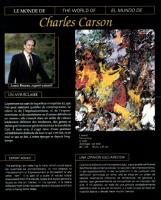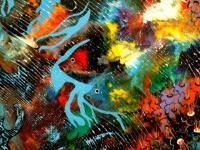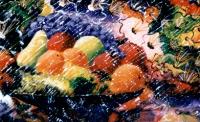 |
|
1992- Study of 16 pages on the work of Charles Carson a new "ISM"; Por Louis BRUENS
|
1992- Analyzes of a new "ism"
Louis Bruens
EXPERT ADVICE
"The painting I am referring to here, which could easily be qualified as contemporary, is not related to Impressionism or Expressionism or Surrealism or any other "ism". It is part of a scale of values totally dissociated from the trends, types and style generally found on the art market. Im my opinion, it is totally different from what has been done in the past and from what is being done today.
As long as there are enthusiastic collectors and innovative artists, showrooms, art galleries, museums and the art market will continue to exist. The artist referred to here and whose works I have analyzed belongs to that race of creators one comes across only after a long and patient search. In my case, it took 33 years. I had a vague idea that my patience would one day be rewarded and it was, the first time I encountered one of Charles Carson’s painting. I knew immediately that it was he, the painter, the artist, that long awaited rare avis who would bring me joy, pleasure and satisfaction.
|

|
|
Detail: Carsonism technique.
|
Now, as I near retirement age, this new form of painting is but one more reason to champion art not only for art’s sake but also for its investment value. From my experience, I have not the slightest doubt of the very promising investment value of Charles Carson’s works in a not-too-distant future.
Surprise is inevitable when viewing a Carson; then, slowly, surely, and serenely, his world unfolds and initial surprise gradually gives way to delight.
Charles Carson is not a non-figurative painter with the meaning of this term. His paintings must be viewed as a detailed group of everyday things, some of which are immediately obvious while others can only be discovered after contemplation. None of the objects he paints are really or truly deformed in spite of their appearance which is due rather to the effervescent colors; after a few seconds of visual meditation, they appear in a reality all their own.
Charles Carson has indeed developed a new method of transposing nature and its objects in a way that corresponds perfectly with the rules of aesthetics in composition and chromatic intensity.
|
 |
|
"La résurection"
|
His is a new art form, very much part of contemporary art yet accessible to all.
Nothing is left to chance; the relationship between the artist and nature is immediately defined. What is curious, however, is that one or several elements are always carefully and strangely hidden only to be revealed gradually to the receptive… and patient spectator.
The perfect coordination of planes, the harmony of rhythm, the dynamic organization and the brilliance of Carson’s palette bring to mind the best and wonderful Riopelles of the 50s and 60s
Early in my career in art, around 1959, I fell in love- head over heels in love – with the works of two Quebec artists – Marc-Aurèle Fortin and Riopelle. Both were great artists: two schools, two mind sets and two very different forms of pictorial expression; yet the beauty of their art was in itself a promise of success. Since then, I have met many artists- good ones, a few excellent ones and many others; I very rarely speak out publicly on the quality of painting but this time, I cannot refrain from expressing my enthusiasm for this latest and probably last love affair: Charles Carson’s painting.
In terms of investment, what was true twenty years ago remains true today, even more so than ever. In the book “Investir dans les oeuvres d’art” (Investing in Works of Art) published in 1978, I wrote that there were two types of investment: aesthetic investment, and what doesn’t hurt at all, financial investment. And referring to collections, I added that a large fortune has been built by systematically collecting paintings. In 1976, when questioned by a shareholder who was concerned about money spent acquiring painting, David Rockefeller scathingly replied: “These investments cost $500,000 and are worth more than $3 million today. Do you know of a more profitable sector?”
The Rockefellers are not neophytes in the art of investing and making money and as far as collecting was concerned, they certainly were not purchasing paintings blindly but were probably seeking out quality artists as good investments. The works of Charles Carson are an example of a good investment since they are constantly sought after by investors and collectors.
|

|
|
Éclipse de fruits, détail carsonism
|
Painting is an almost visceral need with Charles Carson. Yet, he rejects complacency or more specifically creating popular paintings to please anyone and everyone at any price.
It bears repeating that Charles Carson’s art is not abstract and if some specialists consider it to be such, they should add that it is a much lesser degree of abstraction than pure abstraction. Very recognizable figurative forms immersed in a world of relatively undefined configurations perhaps, but always directly related to the dominant elements.
As a creator, the artist has the inalienable right to convert the concrete images he sees into different ones based on his own sense of aesthetics and Carson does indeed do this. He transposes sensations that only he knows and in each of his paintings attempts to share his world of dreams, thoughts and emotions with us. Obviously, I believe that only a privileged few, from a long line of connoisseurs no doubt, can really penetrate the secret world of this artist/creator – those who have already rejected the insipid, perpetual painted images lacking in vibrancy and joy still found in the many small salons…of many small-minded people.
|
 |
|
"L' oiseau marin des mers tropical"
|
Charles Carson set a basic rule for himself when he began in the mysterious world of painting around 1978. He would not move into the art market before reaching his own objective which was to create a new form of painting that in no way resembled any past or present form or style. He devoted fourteen years to work, research, experimenting and discipline, never taking the easy way out, before discovering the colourful, luminous and spontaneous pictorial expression that is his today.
Charles Carson’s bold and fascinating chromatic compositions remind us of what Kandinsky wrote in 1910 in “Uber das geistige in der kunst” ( The Spiritual in Art): “ The boldness of color in a painting must attract the spectator forcefully and at the same time mask the deeper content. The colors of Carson’s palette do not mask, they slowly reveal with equal depth what they seem to hide initially and still succeed in maintaining the spectator’s entire attention as he more or less consciously continues to seek out new elements.
|
|
|